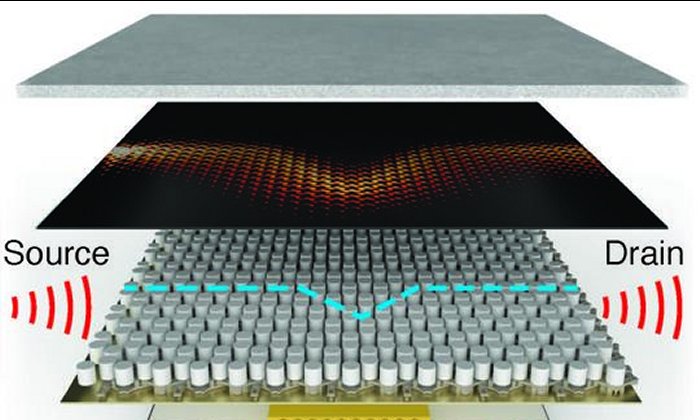Eddie Gonzales Jr. – MessageToEagle.com – Topological materials move electrons along their surface and edges without any loss, making them promising materials for dissipationless, high-efficiency electronics.
Researchers are especially interested in using these materials as transistors, the backbone of all modern electronics. But there’s a problem: Transistors switch electronic current on and off, but it’s difficult to turn off the dissipationless flow of electrons in topological materials.
To turn ‘on’ an acoustic transistor, ultrasound arriving at the ‘gate’ input heats and expands the base plate, changing the spacing in two lattices of slightly-different-sized pillars, and inducing a topological transition that guides sound along the interface. (Credit: Hoffman Lab/Harvard SEAS)
Now, Harvard University researchers have designed and simulated the first topological acoustic transistors — with sound waves instead of electrons — and proposed a connection architecture to form a universal logic gate that can switch the flow of sound on and off.
“Since the advent of topological materials around 2007, there has been a lot of interest in developing a topological electronic transistor,” said Jenny Hoffman, the Clowes Professor of Science at the Harvard John A. Paulson School of Engineering and Applied Sciences (SEAS) and the Department of Physics.
“Although the materials we used won’t yield an electronic topological transistor, our general design process applies to both quantum materials and photonic crystals, raising hopes that electronic and optical equivalents may not be far behind.”
By using acoustic topological insulators, the researchers were able to sidestep the complicated quantum mechanics of electron topological insulators.
“The equations for sound waves are exactly solvable, which allowed us to numerically find just the right combination of materials to design a topological acoustic waveguide that turns on when heated, and off when cooled,” said Harris Pirie, a former graduate student in the Department of Physics and first author of the paper. Pirie is currently a Marie Curie Postdoctoral Fellow at Oxford University.
The researchers used a honeycomb lattice of steel pillars anchored to a high-thermal-expansion plate, sealed in an air-tight box.
The lattice has slightly larger pillars on one half, and slightly smaller pillars on the other half.
These differences in size and spacing of the pillars determine the topology of the lattice, whether sound waves can travel along a designated channel or not. The researchers then designed a second device that converts ultrasound into heat.
The heat expands the pillar lattice and changes the topology of the waveguide.
When coupled together, these two devices allow the output of one waveguide to control the state of the next, just as the electrons flowing in a conventional transistor can toggle other transistors.
Written by Eddie Gonzales Jr. – MessageToEagle.com Staff








